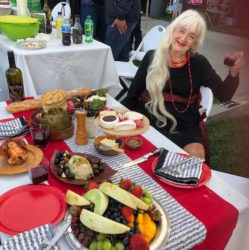by Geraldine Duncann
“I rose before dawn and baked the loves that had been risen during the night. Have a bit of a backache. Set to rise more loaves, fed the stock and finished the morning chores and we were on our way with the sun rise. When we stopped at noon, I baked the risen loves and set more to rise. After watering the stock in the nearby creek, we were on our way again. Now that we are in the high country there is always good water. Back ache increasing and I told George I would have to ride some of the way now. At evening we made camp by the large lake we had seen for most of the afternoon. Baked the bread, set in more loaves to rise for breakfast, finished the evening chores and was delivered of a son. George says he hefted more than a 10 pound weight. He is a Californian, born our first day in this new land.”
That is an entry as I remember it read to me from the journal of my maternal Great-Grandmother, Martha Herndon, who left Virginia on her wedding night with a new husband and headed west to a new life in a new land. The daily bread was made from a starter she kept safe in a small crock tucked away in the center of the flour barrel. It arrived in California with her before the gold rush. Someone in our family has kept it alive ever since.
~Geraldine Duncann
Sourdough bread takes its name from the sour flavor which it can develop due to the high percentage of Lactobacillus. This happens because of the high percentage of lactic acid bacteria in the starter. Modern commercial yeast is most commonly Saccharomyces cerevisiae, brewer’s yeast, which does not have the sour flavor. While virtually all conventional yeast leaven will always contain some lactic acid microorganisms, their effect will be minor and not easily noticed in the flavor of the bread. In a true sourdough, the lactic acid bacteria will be rich and flavorful. There are many strains of Lactobacillus, which contributes to the variety of flavors of sourdough breads.
Many people name their sourdough starter. In our branch of the family, we call ours “Melissa,” for my great-grandmother, one of the brides to whom was given the duty of caring for that family starter. For those of you who have ever been given a cup of Melissa, the following is how to make it go forth and prosper:
Place the starter you received in a bowl and add 2 cups of flour and 2 cups of tepid water. Stir well with a wire whisk. Add ¼ cup of sugar and whisk again. Set aside in a warmish place and cover with a cloth. If you wish to add a lid, that is fine. You just want to be sure no flying vermin or pets can get into it.
When the starter is “working,” sort of bubbly and frothy and has a pleasant sourish aroma, put it in whatever container you are going to keep it in. It should be glass, plastic or ceramic. Just a quart Mason jar is fine. I have a nice little ceramic crock with a wire bale lid.
You should try to use your starter at least once a week to keep it healthy. If you can’t use it, you can still keep it happy. Once a week discard half of it, stir in one cup of flour and one cup of tepid water, stir well and leave sit un-refrigerated for two or three hours, then put it back in the fridge.
Do not introduce eggs, dairy, fat of any sort or salt into the starter. If you want those things in your bread, add them to the sponge, but only after you have removed your starter from the bowl.

Starting From Scratch:
For those can’t get a cup of Melissa, not to worry. You can easily make your own. Unless flour has been heated to the point of killing every living thing in it, there is enough wild yeast in the flour to create sourdough.
Put two cups of flour and two cups of filtered water in a bowl, mix well and cover. Allow to sit in a warmish place. When you see bubbles, add another cup of flour and a cup of water. The next day, remove half of the starter and add fresh flour and water. Keep repeating this for a week or however long it takes.
Some days, your starter will be very bubbly, and other days it will hardly do anything. This is normal. The yeast and other beasties in it are sorting themselves out. It can take several days to a few weeks for a starter to stabilize its yeast colony.
Once the starter seems stable, you can keep it in a jar in the refrigerator, taking in out every few days to feed and/or use.
A Word of Warning:
Be it Wild Yeast or Commercial Yeast, there are a few things you must remember:
- DO NOT use the microwave in any part of the process when you are working with yeast. It will kill it dead, dead, dead! Also, do not use any utensils that are made of reactive metals; iron, tin, aluminum. Don’t even use enamel because the enamel may be chipped and there will be tin or iron underneath.
- Use only glass, plastic, wood or stainless steel bowls, spoons or storage containers while working with your sponge or dough.
Basic Frontier White Bread
This is an excellent basic bread that is good as it is, or as the basis for a variety of other breads.
Sponge
Put starter in a bowl.
Add:
2 cups all-purpose flour
2 cups tepid water
1/4 cup sugar or honey
Stir exceedingly well, cover with a clean cloth, and set in a warm not hot place and leave until light and spongy. Time will vary greatly depending on the weather conditions. I have had it take from 1 to 6 hours, usually about 2 hours, though it is so forgiving I can leave it overnight. When your sponge is bubbling and spongy, refill your starter crock with 2 cups of the sponge and refrigerate that for the next use.
To the sponge remaining in the bowl add:
1/4 teaspoon nutmeg
1 teaspoon salt (optional)
4 cups un-bleached flour (the amount may vary slightly depending on conditions such as humidity.
Stir until the dough is too stiff to stir any longer, then turn it onto a flat surface and knead exceedingly well. More bread goes wrong from inadequate kneading than any other reason. The result should be smooth, satiny, and elastic in texture.
Wash the bowl, dry well and lightly oil. Put the dough into the bowl and leave in a warm, not hot, place to rise until double iin bulk. When properly risen, turn out onto a lightly flowered surface, punch down and very lightly knead. Return to the bowl and leave to double in size again.
After the dough has risen the second time, punch down, knead lightly, and form into 1 large or two smaller round or oval loaves.
Place the loaves on an oiled baking sheet or a baking sheet that has been lined with baking parchment. Make three or four slashes in the top of each loaf and leave it to double in bulk. Paint the surfaces with an egg white beaten with 1 tablespoon water. Place in a pre-heated 350-degree oven and bake for 40 to 50 minutes. When done, the bread will be golden brown and sound hollow when tapped.
If you wish a crisp crust, place the loaves on wire racks and allow to cool. If, however, you wish a tender moist crust that may be easily sliced, paint the loaf lightly with melted butter and wrap in clean cloth, or place inside a double paper bag and leave until cool.

